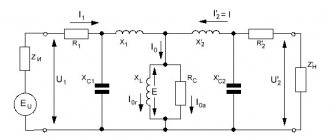The properties of the magnetic field have been studied by scientists for a long time. Electromagnetic induction was first described by Michael Faraday. Namely, how a strong electromagnetic relationship appears in the windings when alternating current is created in the first coil. In the secondary coil, the voltage increases, but the power and frequency remain the same. Of course, it is difficult for an ignorant person in electricity to understand the design, operating principle, and purpose of a transformer. However, this is an integral device with installation in many areas: radio engineering, electrical power engineering.
Voltage transformers: purpose and principle of operation
A transformer is an electrical device. Converts alternating current of one voltage into electric current of another voltage. The frequency, according to the phenomenon of electromagnetic induction, remains unchanged.
A static transformer consists of:
- primary and secondary windings;
- core.
The device is used in different power circuits and electrical appliances. Transmits electricity over long distances and:
- reduces energy losses;
- reduces the cross-sectional area of power transmission line wires.
Types of device:
- increasing;
- downward;
- power;
- rotating;
- pulse;
- dividing;
- coordinating
A step-down transformer is used in everyday life. It is through it that current passes and enters home sockets with a power of 220 W.
A power unit consisting of a core and several windings converts voltage into electrical circuits using the principle of electromagnetic induction. Also the value of AC voltage without changing its frequency. Used for distribution and transmission of electrical energy. The voltage in the windings is over 300 kV. Power – from 4 kV to 200,000 kVA.
Reference! The transformer is used to lower or increase alternating voltage. The basis is a ferromagnetic core. In addition, for uninterrupted operation - windings, insulation, magnetic circuit, cooling system.
The windings are made of insulated copper wires of rectangular cross-section. Between their layers there are voids for the circulation of cooling oil. The role of which is to take heat from the windings and transfer it through the radiator tubes to the environment.
The operating principle of the device is based on:
- change in magnetic flux;
- creating electromagnetic induction when passing through the winding;
- supplying voltage to the primary winding;
- reproduction of magnetism by an electric current that changes over time.
Alternating current flowing through the primary winding begins to create a magnetic current in the magnetic circuit. Gradually leads to flux in all windings, transforming the galvanic isolation (alternating voltage), but without changing the frequency.
Worth knowing! The operation of the device is based on electromagnetic induction. Due to alternating current, an alternating magnetic field is formed around the conductor and is modified into an electromotive force. The output voltage completely depends on the transformer used (step-down, step-up). The EMF coefficient in the windings is directly proportional to the number of turns.
Main parameters of power transformers
POWER TRANSFORMER AND ITS PARAMETERS
A power transformer is a stationary device with two or more windings that, by means of electromagnetic induction, converts an alternating voltage and current system into another alternating voltage and current system, usually of different values at the same frequency, for the purpose of transmitting electricity without changing its transmitted power.
Power transformers installed in power plants and substations are designed to convert electricity from one voltage to another. Three-phase transformers are most widespread, since losses in them are 12-15% lower, and the consumption of active materials and cost are 20-25% less than in a group of three single-phase transformers of the same total power.
Three-phase transformers for voltage …………………………………………….. 220 kV are manufactured with a capacity of up to 1000 MVA, for 330 kV - 1250 MVA, for 500 kV - 1000 MVA, 750 kV - 3 * 417 MVA, 1150 kV - 3 * 667 MBA. The specific unit power of transformers is limited by weight, size, and transportation conditions.
Single-phase transformers are used if it is impossible to manufacture three-phase transformers of the required power or their transportation is difficult. The highest power of a group of single-phase transformers with a voltage of 500 kV is 3 * 533 MVA, with a voltage of 750 kV - 3 * 417 MVA, with a voltage of 1150 kV - 3 * 667 MVA.
Based on the number of windings of different voltages per phase, transformers are divided into two-winding and three-winding. In addition, windings of the same voltage, usually low, can consist of two or more parallel branches, isolated from each other and from grounded parts. Such transformers are called split-winding transformers. The windings of high, medium and low voltage are usually abbreviated as HV, MV, LV, respectively. Transformers with split LV windings provide the ability to connect several generators to one step-up transformer. Such enlarged power units make it possible to simplify the design of 330-500 kV switchgear. Transformers with split LV windings have become widespread in power supply circuits for the auxiliary needs of large thermal power plants with units of 200-1200 MW, as well as at step-down substations in order to limit short-circuit currents.
Main parameters of power transformers
The main parameters of the transformer include: rated power; voltage; current; short circuit voltage (SC); no-load current (xx); xx losses and short circuit losses.
The rated power for a two-winding transformer is the power of each of its windings. Three-winding transformers can be made with windings of the same or different power. In the latter case, the larger of the rated powers of the individual windings of the transformer is taken as the rated power.
The rated power of the autotransformer is taken to be the rated power of each of the parties that have an autotransformer connection between them (“passing power”).
The rated voltages of the windings are the voltages of the primary and secondary windings when the transformer is no-load. For a single-phase transformer, this is its linear (phase-to-phase) voltage. For a single-phase transformer designed to be included in a three-phase group connected in a star, this is U/Z. When the transformer is operating under load and the rated voltage is supplied to its terminals of the primary winding, the voltage on the secondary winding is less than the rated voltage by the amount of the voltage drop in the transformer.
The transformation ratio of a transformer is the ratio of the rated voltages of the high and low voltage windings.
In three-winding transformers, the transformation ratio of each pair of windings HV and LV, HV and MV, MV and LV is determined.
The rated currents of a transformer are the values of currents in the windings indicated in the factory passport at which long-term operation of the transformer is allowed. The current rating of each transformer winding is determined by its power rating and voltage rating.
Short circuit voltage Uk is the voltage, when applied to one of the windings of the transformer while the other winding is short-circuited, a current equal to the rated current passes through it. The short-circuit voltage determines the voltage drop in the transformer and characterizes the impedance of the transformer windings.
In a three-winding transformer, the short-circuit voltage is determined for any pair of its windings with the third winding open. Thus, a three-winding transformer has three values of Uk .
For all transformers, the short-circuit voltage in % of the rated voltage is calculated using the following formula
Uк =√(Ua2+Up2),
where Ua is the active component of the short-circuit voltage, depending on the active resistance of the transformer; Up is the reactive component of the short-circuit voltage, depending on the reactance (inductive) resistance of the transformer.
By increasing the value of Ucz, it is possible to reduce the short-circuit currents on the secondary side of the transformer, but at the same time, the consumed reactive power increases significantly and the price of transformers increases. If a 110 kV, 25 MVA transformer is made with Uc = 20% instead of 10%, then the calculated costs for it will increase by 15.7%, and the consumed reactive power will double (from 2.5 to 5.0 MVAr).
The no-load current characterizes active and reactive losses in steel and depends on the magnetic parameters of the steel, the design and properties of the magnetic circuit assembly, and magnetic induction. No-load current is expressed as a percentage of the rated current of the transformer.
No-load and short-circuit losses determine the efficiency of the transformer.
Short-circuit losses consist of losses in the windings when load currents flow through them and additional losses in the windings and structures of the transformer. Additional losses are caused by magnetic stray fields that create eddy currents in the outer turns of the winding and transformer structures (tank walls, yokes, etc.). To reduce them, the windings are made with multi-core transposed wire, and the walls of the tank are shielded. In modern transformer designs, losses are significantly reduced. The lower the power of the transformer, the greater the relative losses in it. A huge number of low and medium power transformers are installed in power supply networks, therefore the total losses of electricity in all transformers in the country are significant.
Why do you need a voltage transformer?
A voltage transformer is a universal device. Transmits and distributes energy.
Used in:
- electrical installations;
- power supplies;
- power transmission units;
- signal processing devices;
- power supplies of devices.
A high voltage power transformer is used for:
- supplying energy to the electrical grid at power plants;
- increasing the voltage of the generator, power lines;
- reducing voltage to consumer level.
A three-phase device with a special cooling system is used in electrical networks. The core in the composition is common to all 3 phases.
The scope of application of the network transformer is power supplies, components of electrical appliances with different voltages. Pulse units are indispensable for radio engineering and electronic devices. First, the alternating voltage in the power supplies is rectified. Next, due to the inverter, high-frequency pulses are converted, stabilizing the constant voltage.
Transformers are included in many power circuits to ensure minimal levels of high-frequency interference. For example, separation devices prevent the risk of electric shock to humans. After all, connecting household appliances to the network through a transformer becomes safe.
The second circuit of the device will be isolated from contacts with the ground, unless, of course, we are talking about grounding electrical equipment. Power measuring instruments are used in alternating current generator circuits. The number of phases of the generator from the transformer must match to achieve a stable output voltage.
Matching transformers are indispensable for electronic devices with high input impedance and high-frequency lines, but with different load impedances.
Measuring voltage transformers. Design, classification, principle of operation, examples
In addition, the use of voltage transformers in electrical installations makes it possible to isolate low-power, low-voltage measuring instruments and devices, which reduces the cost and allows the use of simpler equipment, and also ensures the safety of servicing electrical installations.
Voltage transformers are widely used in high voltage power electrical installations
The accuracy of commercial metering of electricity, the selectivity of the action of relay protection and emergency automation devices depend on the accuracy of their operation, they also serve to synchronize and power automatic relay protection of power lines from short circuits, etc.
Such transformers are equipped with connectors for connection: the primary winding is connected to power voltage circuits, and relays, voltmeter or wattmeter windings, and other devices can be connected to the secondary winding. Their operating principle is similar to that of a power transformer: the voltage in the measuring transformer is transformed by an alternating magnetic field.
For an interesting video about the operation and design principle of current transformers, see below:
Magnetization losses cause some error in accuracy classes.
- magnetic circuit design;
- permeability of steel;
- power factor, i.e. depends on the secondary load.
The design provides compensation for voltage errors by reducing the number of turns of the primary winding and eliminating angular errors using compensating windings. The simplest circuit for connecting a voltage transformer
How does a voltage transformer work?
The devices convert the source energy into the required voltage coefficient. They operate exclusively at alternating voltage with a constant frequency. The work is based on electromagnetic induction as a phenomenon triggered by a change in magnetic flux over time, generating an EMF in the windings.
The operation of a transformer begins in the primary winding, where the core creates magnetic flux. Next, alternating current is activated, magnetizes the core, increases the inductance of the primary winding, and prevents the increase in current at the terminals of the voltage winding. If the primary winding gives off magnetic flux, then the secondary winding receives it, changes at a certain speed, penetrating all branches and creating an EMF.
The voltage on the branches depends entirely on the rate of change of the magnetic flux in the core. Although it turns out the same on the branches of the primary and secondary windings due to the passage of the same magnetic flux through them.
It, in turn, creates an electric field around itself in the core, a kind of vortex with an effect on the electrons, starting to push them in a certain direction.
Reference! To put it simply, the principle of operation of a voltage transformer is based on excitation of voltage in the second winding due to the alternating current generated in the magnetic circuit.
How does an autotransformer work?
Among transformer devices, simplified designs are especially popular, using not two different separately made windings, but one common winding, divided into sections. They are called autotransformers.
Autotransformer device diagram
The principle of operation of a transformer of such a circuit remains practically the same. The input electromagnetic energy is converted into output energy. Primary currents I1 flow through the turns of winding W1, and secondary currents I2 flow through W2. The magnetic core provides a path of movement for the magnetic flux F.
The autotransformer has a galvanic connection between the input and output circuits. Since not all of the applied power of the source is converted, but only part of it, a higher efficiency is created than that of a conventional transformer.
Such designs allow you to save on materials: steel for the magnetic core, copper for the windings. They are lighter in weight and cost. Therefore, they are effectively used in energy systems from 110 kV and above.
There are practically no special differences in the operating modes of a transformer and an autotransformer.
Voltage and current instrument transformers
Devices operating under high voltage require periodic measurements.
For these purposes, measuring devices that:
- reduce the voltage to the desired level;
- provide galvanic isolation of measuring equipment from circuits with increased danger.
Rated power, voltage and current
Rated - the power with which the transformer operates in a certain accuracy class and in accordance with GOST. Expressed in volts, amperes. Minor power deviations are allowed, but not higher than the normalized values.
Important! To avoid increasing the secondary load error, the total consumption of the windings of measuring instruments and relays should not be more than the rated power of the transformer. You can find out the rated power in the passport for the unit or on the dashboard.
The rated voltage threshold of the transformer is 10 kV.
The difference depending on the power of electrical appliances is for:
- power supply for electrical receivers - 3-6.3 kV;
- large-sized electric motors - up to 1000V.
The power of a three-phase transformer is subtracted by the formula: - S = square root of the number 3 UIU - rated phase-to-phase voltage, V; / - current in phase, A. The coefficients of operating currents in the windings in the operating state of the transformer should not be higher than the rated ones. Although short-term overloads in oil and dry units up to certain limits (2.5 -3%) are acceptable.
Three-phase transformer
Among the electromagnetic devices of this type, the three-phase transformer stands out. It has magnetic and galvanic phase connections. The presence of a circuit of the first type is due to the connection of magnetic circuits into one system. In this case, the magnetic fluxes are located relative to each other at an angle of 120 °. A rod is not needed in this system, since when the centers of the three phases are combined, the sum of the electromagnetic channels is equal to zero, regardless of time. Thanks to this, a circuit with six rods is converted into a three-rod one.
Three types of circuits can be used to connect the windings of the device:
- A star connection can be made with or without output from common points. Here each winding is connected to a neutral point.
- According to a triangular diagram, the phases are connected in series.
- Zigzag is a pattern that is most often used during retraction from a common point. It connects three windings located on different magnetic cores.
The use of a three-phase transformer is more economical than the use of connected single-phase structures.
Voltage transformer load
The secondary load of the voltage transformer is the power of the external secondary circuit. The rated secondary load is understood as the highest load at which the error does not exceed the permissible limits established for transformers of a given accuracy class.
Voltage transformer designs
In installations with voltages up to 18 kV, three-phase and single-phase transformers are used; at higher voltages, only single-phase transformers are used.
At voltages up to 20 kV there are a large number of types of voltage transformers: dry (NOS), oil (NOM, ZNOM, NTMI , NTMK), with cast insulation ( ZNOL ). It is necessary to distinguish single-phase two-winding transformers NOM from single-phase three-winding transformers ZNOM. Transformers of types ZNOM-15, -20 -24 and ZNOL-06 are installed in complete conductors of powerful generators. In installations with voltages of 110 kV and higher, cascade-type voltage transformers NKF and capacitive voltage dividers NDE are used.
Voltage transformers
Instrument voltage transformers are designed to reduce primary voltages to values that are most convenient for connecting measuring instruments, protection relays, and automation devices. The use of instrument transformers ensures the safety of workers, since the high and low voltage circuits are separated, and also makes it possible to unify the design of devices and relays.
What is the difference between a current transformer and a voltage transformer?
By definition, these devices are designed to work with different electrical quantities as basic ones and, accordingly, the switching circuits will be different. For example, a current transformer is powered by a current source and does not work, and may even fail, if its windings are not loaded and no electric current flows through them. The voltage transformer is powered by voltage sources and, conversely, cannot operate for a long time in modes with high current loads
Video: Voltage Transformers
Technical characteristics of voltage transformers, connection diagrams. Factors influencing the accuracy class. Types of voltage transformers, identification of markings.
What is a voltage transformer
Faraday's law
According to the law of electromagnetic induction, an EMF voltage is created in the secondary winding. Calculated by the formula - U2 = −N2*dΦ/dt.
Reference! Faraday's fundamental law of electrodynamics. It states that the generated electromotive force is equal to the rate of change of magnetic flux, but taken with a minus sign. It was Michael Faraday who made the discovery when, during experiments, he announced that electromotive force begins to appear in a conductor only when the magnetic field changes. The magnitude of this force is directly proportional to the rate of change of the magnetic field.
All the facts are contained in one equation. However, the minus sign in the law is Lenz’s rule, which indicates the occurrence of an inductive electric current when the magnetic field in the conductor changes. The action of the current is directed towards the magnetic field, which begins to counteract the change in magnetic flux.
Lenz's rule does not obey the laws of electrodynamics, because induction current appears both in windings and in solid metal blocks.
Transformer losses
When a real transformer operates, there are always energy losses associated with various physical processes:
- heating the transformer windings;
- core magnetization reversal work;
- magnetic flux leakage.
The most significant energy losses are caused by the thermal effect of eddy currents ( Foucault currents
) arising in a massive conductor when the magnetic flux penetrating it changes. To reduce them, transformer cores are made not from a solid piece of metal, but from thin plates separated by the thinnest layers of dielectric (the plates are varnished).
Modern transformers have very high efficiency (95-99%), which allows them to operate with virtually no losses.
Ideal Transformer Equations
In such a transformer, power lines pass through all branches of the primary and secondary windings. This means that there are no vortex flows and energy losses. The magnetic field changes, but generates an identical EMF in all turns, and therefore becomes directly proportional to their total number.
When energy comes from the primary circuit, it is transformed into a magnetic field and then enters the secondary circuit.
The formula for the ideal transformer equation is P1 = I1 • U1 = P2 = I2 • U2:
- R1 is the coefficient of incoming power from the first circuit to the transformer;
- R2 is the coefficient of converted power entering the secondary circuit.
If you increase the voltage at the ends of the secondary winding, the current level of the primary circuit will decrease. According to the equation - U2/U1 = N2/N1 = I1/I2, converting the resistance of one circuit to the resistance of another is possible only by multiplying the value by the square of the ratio.
Connection diagrams
Connection diagrams for single-phase voltage transformers:
Connection diagrams for three-phase voltage transformers:
Diagrams and groups of connections of windings of three-phase three-winding transformers with main and additional secondary windings
Also read: Features of a dry-type transformer











